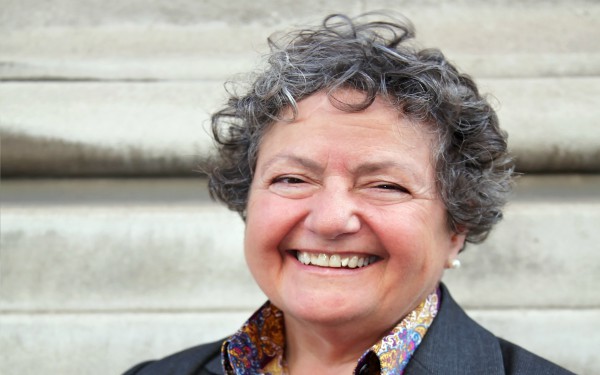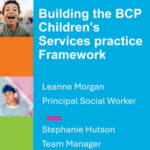
Since Lyn Romeo announced her retirement in October last year, the tributes to the now former chief social worker for adults from across the profession have been warm and fulsome.
Lyn Romeo is without a doubt a social worker for social workers! Will be hugely missed by many and certainly me. https://t.co/S4ck6Tsi7U
— Warren Belcher (@ermate) October 5, 2023
Behind anything that is good in social care over the last 15yrs at a national level, if you look you will find @LynRomeo_CSW was very likely behind it, working quietly & diligently to ensure rights for ppl & support for SWs. A real force for good. We will miss her. Thanks Chief. https://t.co/u5cRw8NXK3
— Rob Mitchell (@RobMitch92) February 2, 2024
‘A great role model for bringing people together’
The Adult Principal Social Worker Network said that Romeo, who stepped down at the end of January, “exemplifies kindness and compassionate leadership”, and was a “great role model for bringing people together”.
These comments capture three beliefs about Romeo’s tenure as chief social worker for adults: that she has achieved things, demonstrated strong social work values and worked collegiately.
Alongside her children and families counterpart, Isabelle Trowler, Romeo has also embedded the role of chief social worker within the civil service.
Though England has had a chief medical officer (CMO) since 1855, and a chief nursing officer (CNO) since 1941, it was not until 2013 that the country acquired its first – and second – chief social workers.
However, despite their short lifespan to date, the roles now appear to be fixtures. The Department of Health and Social Care (DHSC) is now recruiting for Romeo’s successor, while Trowler is at the heart of making the Department for Education’s (DfE) children’s social care reforms a reality.
The blueprint for the chief social worker role
The recommendation to appoint a chief social worker came from Professor Eileen Munro, in the final report of her landmark review of child protection from the government in 2011.
Munro saw the role as serving three overarching functions:
- Providing professional advice to government, including on the challenges in delivering social work services and the profession’s contribution to achieving local and national outcomes.
- Promoting improvements to social work, including the adoption of evidence-informed practice.
- Promoting social work’s role in society and raising public awareness of, and confidence in, the profession.
One chief or two
While Munro recommended the creation of a single role, spanning children’s and adults’ services, the government struggled to recruit an overarching chief social worker.
So, in 2012, ministers decided to appoint two chiefs – one for each service. The move was criticised at the time by the British Association of Social Workers (BASW) and the then College of Social Work as undermining social work’s integrity as a single profession.
Twelve years on, Romeo is convinced this was the right decision.
“I think it would be quite challenging to have someone overseeing that across two departments and the complete social work sector,” she says. “I think in the end it’s worked well that there have been two of us.”

Isabelle Trowler, chief social worker children and families (left), with Lyn Romeo
Of her relationship with Trowler, she says: “We’ve worked really well together and had a real impact on those shared areas.”
Embedding social work values in practice
When asked about her key achievements as chief, Romeo says social work values and approaches are now much more central to adult social care than they were prior to 2013, as embodied in the Care Act 2014.
The legislation, which started its journey through parliament just as Romeo took up her post, made promoting wellbeing the first principle of adult social care.
As set out in section 1 of the act, this included promoting a person’s control over day-to-day life, including their care and support. Also, assessments became focused on identifying the person’s desired outcomes, with councils required to consider how these could be met other than through the provision of care and support (sections 9 and 10).
This should include considering the person’s own strengths and their support network, according to the statutory guidance under the act, which councils are required to follow other than in exceptional circumstances.
Championing strengths-based approaches
While Romeo was not involved in the drafting of the Care Act, she has since sought to embed its strengths-based principles in practice.

Photo: fotolia/daoduangnan
Notably, in 2019, the DHSC, at Romeo’s initiation, published a strengths-based practice framework and handbook. This defined a strengths-based approach, rooted it in the Care Act, set out what the key enablers were to make it happen and gave case studies.
Romeo says it has probably been the most influential of the many pieces of practice guidance produced during her tenure.
Not only has it been adopted in several areas but it is also referenced in the Care Quality Commission’s new framework for assessing the quality of local authorities’ delivery of their Care Act functions, she says.
‘Social work as we know it’
“It’s social work as we know it – deep listening, getting alongside people, choice and control, supporting people to have input into the lives they want to lead, protecting human rights, inclusion and taking a holistic systemic approach.
“It’s been a big move away from a commodified, assessment, care and support planning, reviewing approach. I think we’ve been able to shift that story.”
This view, and Romeo’s part in it, is endorsed by the Adult Principal Social Worker Network, who said she had “transformed social work with adults over the past ten years”, by championing “a return to relationship-based, strengths-based and rights-based social work”.
However, while Romeo’s commitment to strengths-based practice is in no doubt, achieving it against a backdrop of rising demand and constrained finances has been challenging.
Social workers ‘expected to be box-tickers’, peers told
Following an inquiry into adult social care in 2022, a House of Lords committee said it was told by many witnesses about the perceived disparities between the act’s ambitions and practice on the ground.
People were expected to adapt to “the narrow range of services that are on offer”, with disabled and older people not seen as experts in their lives.
Many witnesses praised some social workers for supporting a vision of adult social care as enabling equal lives, but they said practitioners were “met with a system that requires them to become ‘checklist completers and box-tickers’”.

Credit: Ralf Geithe / Adobe Stock
Romeo acknowledges the “demand, need, resources, the challenging context within which people are working across health, social care, local government”.
‘This is not about care management anymore’
“But I do think that when I’ve been out to visit teams, that shift to strengths-based conversations, looking to how people can be better connected to community resources, how people can be involved in conversations about who cares, what can be done [has been evident],” she adds.
“I think people who are there do feel better supported – that this is about social work and not about care management anymore.”

Lyn Romeo (second right), flanked by past, present and future chairs of the Adult PSW Network. Photo courtesy of the Adult PSW network.
Another way social work has become more central to social care is in the role of the adult PSW in local authorities.
Rise of the PSW
Romeo helped ensure an update to the Care Act statutory guidance in 2016 included expectations on councils to appoint an adult PSW with the “credibility, authority and capacity to provide effective leadership and challenge”.
The status of the role was underlined when the government introduced controversial legislation in 2020 enabling councils to stop applying some of their Care Act duties during the pandemic.
 Guidance on the so-called Care Act easements stated that these should be implemented “with or on the recommendation of the principal social worker”.
Guidance on the so-called Care Act easements stated that these should be implemented “with or on the recommendation of the principal social worker”.
Romeo herself was on extended leave at the time, caring for her mother in Australia.
She left the chief’s role in the hands of Fran Leddra – then a PSW – and Mark Harvey, who had previously been a principal social worker.

Fran Leddra, former interim chief social worker and now a consultant
“It was a really tough time during Covid and I want to acknowledge how well Fran and Mark did in covering through one of the most challenging times,” she says.
“They did a really great job.”
Promoting social work research
Also a source of pride for Romeo is the work she has done to raise the profile of research in adult social work. This started with a project with the James Lind Alliance (JLA) to identify the top 10 priorities for adult social work research, which were published in 2018.
These included the impact of available funding and the Care Act on practice, adult social workers’ influence on people’s wellbeing, how far the Mental Capacity Act 2005 had been embedded and effective interventions with people who self-neglect.
A 2022 evaluation by King’s College London identified research carried out since the publication had addressed each of the questions, though Romeo said subsequently that there was “a considerable way to go to address these questions fully”.
She says there’s now a “much more developed architecture around social work” through the programme of research financed by the National Institute for Health and Care Research (NIHR), which is itself funded by the DHSC.
Funding for research projects
In 2019, following the JLA report, the NIHR launched its research for social care (RfSC) programme, which has subsequently invested £13m in different studies. This was succeeded last year by the research programme for social care (RPSC), which has a budget of £10m.
Also in 2019, the NIHR announced £135m over five years for 15 partnerships of universities, councils and NHS bodies to conduct research into key health and social care issues in their respective regions. One of these applied research collaboratives (ARCs), in Kent, Surrey and Sussex, focuses on social care and social work.

Photo: Feng Yu/Adobe Stock
As well as more research funding, there are now increased opportunities for social workers to get involved with evidence gathering.
Opportunities for social workers
In 2021, the NIHR launched its local authority academic fellowships (LAAF) programme, providing social workers and other practitioners with protected time to do master’s level-research, PhDs or post-doctoral studies while retaining their existing employment contracts and salaries.
In the same year, it also started the local authority short placement award for research collaboration (LA SPARC), providing practitioners with the opportunity to gain research experience within NIHR or academia through short-term placements.
Last year, an advisory group set up by Romeo, along with BASW, produced a charter for social work research in adult social care, to encourage employers and universities to promote these opportunities, and research awareness more generally, in the sector.
It was launched with the backing of NIHR, the Association of Directors of Adult Social Services (ADASS) and five local authorities, with one other council signing up subsequently.
Apprenticeship funding
One of Romeo’s last achievements in post was helping secure agreement for the DHSC to provide £12m to fund up to 400 additional social work apprenticeships within local authority adults’ services over the next year.
With one in ten social worker posts in local authorities lying vacant, despite the workforce growing from 2022-23, increasing recruitment in this way is vital in meeting the demand for practitioners.

Photo: Momius/Adobe Stock
Apprenticeships are the fastest-growing source of recruitment into social work, with 43% growth in the number starting courses from 2021-22 to 2022-23.
Romeo and Trowler’s tenures have also coincided with the launch, and subsequent growth, of government-funded fast-track schemes Frontline and Think Ahead, which train people to work as children’s and mental health social workers, respectively, in just over a year.
The pre-existing 14-month Step up to Social Work course has also expanded during this time, through increased DfE funding.
Romeo’s regret over mainstream social work courses
The Cinderella of the social work education ball has been traditional university courses, for which direct government resources, through student bursaries and placement grants, have been static for a decade.
Community Care has reported on the severe financial challenges this has posed for students.
Romeo says her greatest regret is not overseeing additional investment into these routes.
“I would have liked to have more investment in mainstream routes into social work,” she says.
“What are the incentives to bring people into social work these days when there are lots of different choices who want to make a difference and a public contribution? How do we make social work an attractive option for them?”
Social work ‘still associated with children and families’
She would also like to have seen a greater profile for adult and mental health social work in attracting people into the profession.
“A lot of people who think about it are only aware of children and families social work. When people go on their courses, they tend to think of that as their future.
“However, one of the wonderful things about social work is all the different options there are to apply social work skills and knowledge, including direct work with people of all ages, community work, policymaking, research and academia.”
She says there should be more placement offers for students in adult social care settings – “in local authorities, mental health trusts, specialist services like acquired brain injury services or working in drug and alcohol services, domestic abuse services”.
‘There’s a point you have to pass the baton on’

Lyn Romeo (credit: DHSC)
So why is now the right time to be stepping down?
“It’s a bittersweet thing to give up this role as I’ve absolutely loved it, Romeo says. “But there’s a point at which you have to pass the baton on and bring in other ideas and ways of approaching things.”
And what’s next for the now former chief?
“I will want to make a contribution to social work and social care. I’m going to have a bit of a break for a few months – go to Australia, visit family, have a holiday.
“Hopefully [retirement] will be a mixture of doing some nice things I enjoy doing and making a contribution.”




 Bournemouth, Christchurch and Poole
Bournemouth, Christchurch and Poole  Hampshire County Council
Hampshire County Council  Oxfordshire County Council
Oxfordshire County Council  South Gloucestershire Council
South Gloucestershire Council  Wokingham Borough Council
Wokingham Borough Council  Webinar: building a practice framework with the influence of practitioner voice
Webinar: building a practice framework with the influence of practitioner voice  ‘They don’t have to retell their story’: building long-lasting relationships with children and young people
‘They don’t have to retell their story’: building long-lasting relationships with children and young people  Podcast: returning to social work after becoming a first-time parent
Podcast: returning to social work after becoming a first-time parent  How managers are inspiring social workers to progress in their careers
How managers are inspiring social workers to progress in their careers  Workforce Insights – showcasing a selection of the sector’s top recruiters
Workforce Insights – showcasing a selection of the sector’s top recruiters 

 Facebook
Facebook X
X LinkedIn
LinkedIn Instagram
Instagram
A legacy to be proud of and a well earned retirement! Looking forward to seeing how you keep contributing towards improving adult social work
Can someone provide a list of what the Chief SW has done for SW because I’m scratching me head?